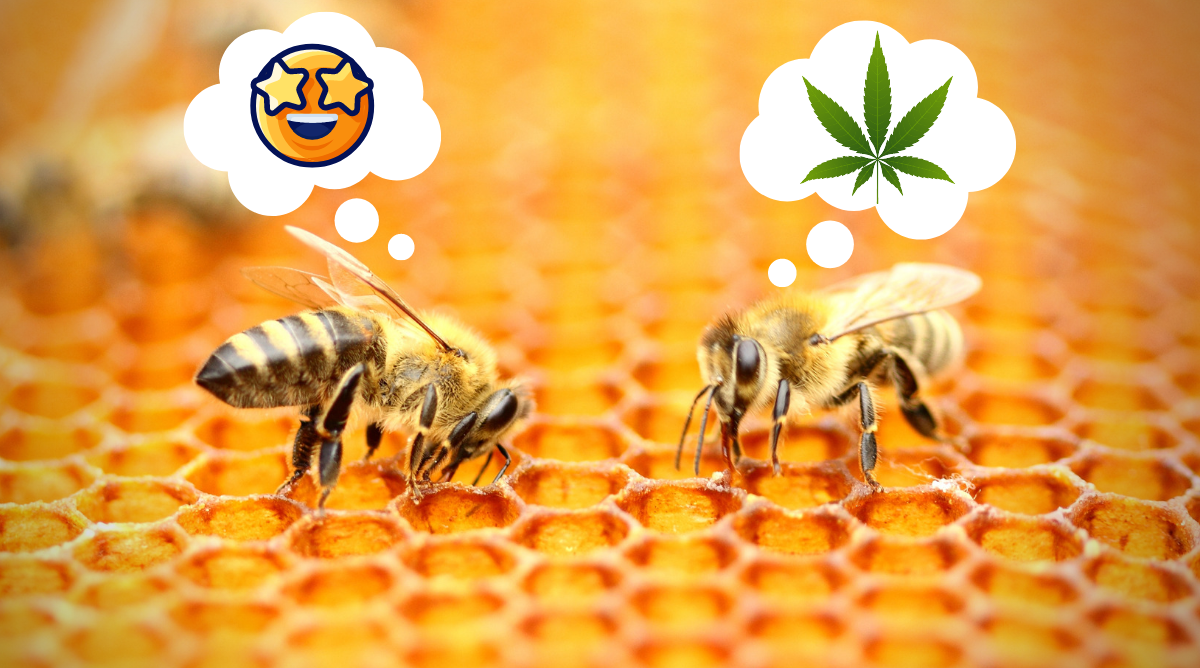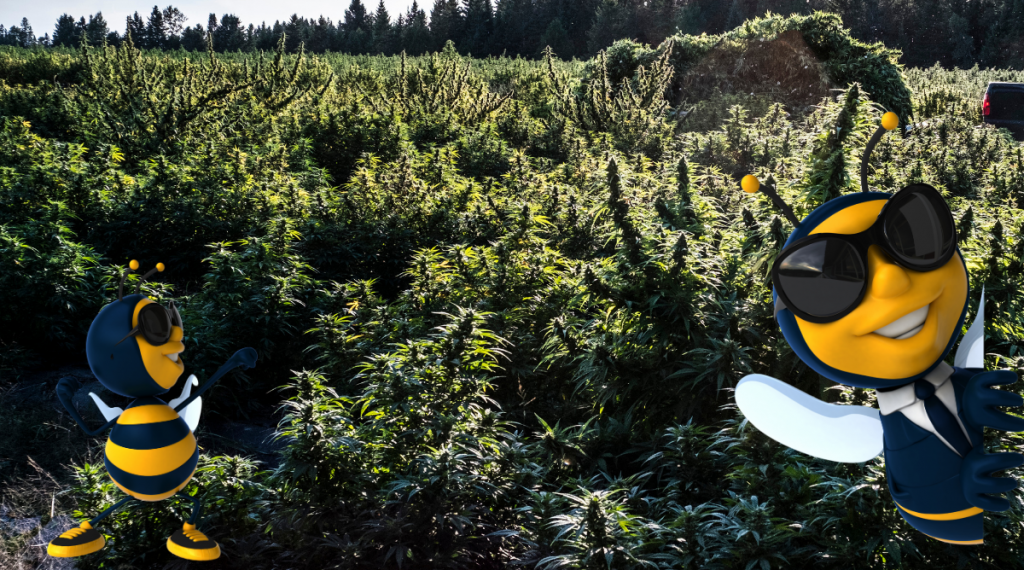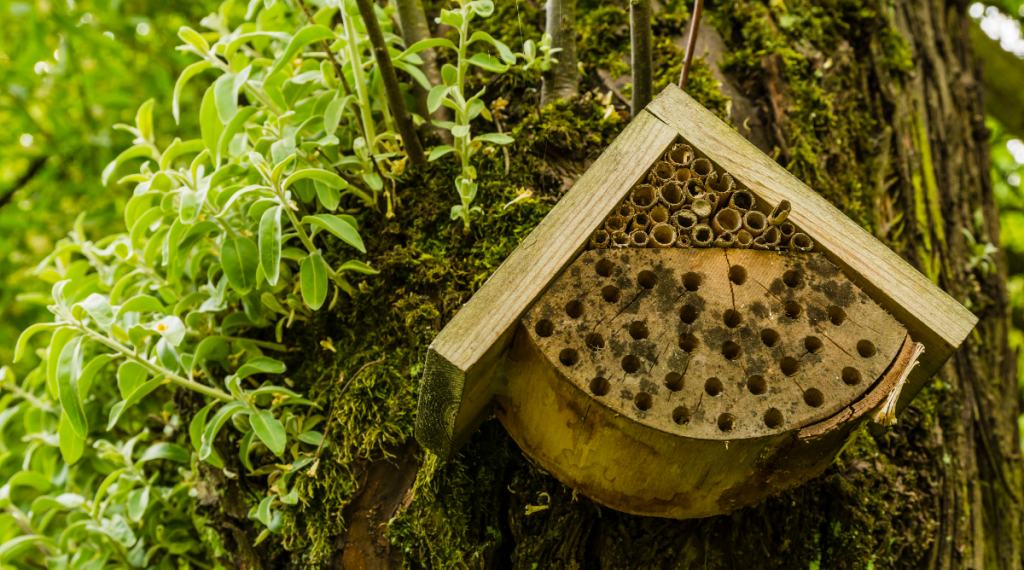
There are more than 20,000 species of bees on the planet. Pretty impressive, right? And of all those species, the human race chose one (the honeybee) to domesticate. Farms learned the value of beekeeping for healthy crops. And, of course, delicious antioxidant-rich honey.
If you love the environment, you’ve probably already heard that bees are in serious trouble. The pollinators of almost every crop on the planet are dying out in massive numbers. About 75% of the crops we rely on, like apples, chocolate, coffee, and other flowering plants.
The United Nations estimated that food production loss (if bees became extinct) is between $235 and $577 billion per year. If we run out of bees, could we do that pollinating ourselves? Japan tried the theory by using drones with limited success. There is something about the method that bees use to pollinate that is hard to replace.
Some exciting new research emerged in 2020. And as the legalization of cannabis advances in America, production is also increasing. Not just in greenhouse facilities, but outdoor cultivation as well. And that could be excellent news for our domestic bee population.
Watch a video featuring Greta Thunberg, and you’ll get a quick understanding of our current environmental threats. The Swedish environmentalist is an eco-warrior, planet guardian, and educator, all by eighteen (18) years. Protecting the bees is one of the causes she is most passionate about.
Climate change has been a significant factor in the loss of many species. In the insect world, it is bringing honeybees to the brink of extinction. The loss of natural habitat and green space is a big problem. Urban cities often do not have nectar-producing flowers to feed bees. And urban residential areas use a high volume of herbicides and insecticides. Both of them are toxic to the honeybee.
The increasing use of GMO or engineered seeds in agriculture is a problem. Some types of vegetables and fruits are being engineered to be self-pollinating. They produce less natural pollen, which reduces the amount of food that bees need to survive.
The year 2007 was a blood bath for bees in North America. About 30% to 70% of honeybee colonies collapsed. The term “colony collapse disorder” refers to thriving bee communities that simply die from lack of food, chemical exposure, lack of water, and volatile weather conditions.

A study conducted by Cornell University revealed some facts about bees and cannabis. It turns out, many species of bees love cannabis. And we thought humans were the only ones that appreciated the healing herb! But honey bees, in particular, find nutritional value in cannabis pollen.
Like any other plant, outdoor-grown cannabis can get a little pollination help from bees. But what the researchers found surprising is that bees prefer male cannabis plants. And the taller, the better. In the study, bees were attracted to male cannabis plants that had a lot of foliage. Taller cannabis plants attracted seventeen (17) times more bees.
Thinking that bees are getting the same buzz from cannabis that we do? The male cannabis plants do not have the same psychoactive properties that female plants do. That’s why female plants produce the cannabis bud or flower. But male cannabis plants produce the pollen. And that pollen is rich in a variety of nutrients, and of course, cannabinoids.
The bee study has coined the phrase “cannabees” to describe honeybee species that loves weed. According to VICE, PhytoPharma International has developed cannabinoid-infused honey and made from bees that have been fed cannabis. The company is based in Israel and has mastered fusing THC and CBD into high-quality commercial honey. Yum.
Indoor cultivation of cannabis for consumers is preferred because greenhouse conditions can be controlled. And cultivators generally prefer indoor growing because there is no soil or nutrient loss or damage from weather. It is also easier to control cross-pollination in an enclosed environment. And avoid the dreaded problem of seeded weed.
There are pros and cons to the industrial cultivation of marijuana outdoors. Greenhouses take a lot of energy to run when you account for lighting and temperature control. This can increase emissions and carbon in the atmosphere.
“In California, estimates show that a single household uses up as much as 8% of energy growing marijuana. That’s roughly using 200 pounds of coal to produce a pound of weed.”
Growing in California
While energy conservation is a high priority worldwide, growing cannabis outdoors is environmentally friendly. Interestingly, the consumer perception is that indoor-grown cannabis produces higher quality bud. But that’s actually not the case.
Outdoor grown cannabis can develop higher levels of flavonoids. That means a stronger taste, with more wellness benefits. Some cannabis connoisseurs even say that they can taste the difference between indoor and outdoor-grown cannabis.
If more vertically integrated cannabis dispensaries and cultivators opt for outdoor growing, bees would also benefit. In subtropical areas of the United States, other pollen-producing plants are seasonal. That means a cyclical dry spell in terms of food for the bees. Cannabis crops are grown on 8–12-week rotations. And that can provide a reliable food source for honeybees.
If you are over the age of forty, you may remember seeing more than a few honey bees around when you were a kid. But now, depending on where you live, seeing a bee can be a rare thing. Not wasps, though. They are jerks, and everywhere.
Does the idea of cultivating honey (in full hazmat gear) scare you a little? Just build them a safe house to help your local bee population. Check out these DIY bee homes you can make with your family.

Planting a pollinator garden is easy! But you have to read the label. Did you know that many big box home improvement stores sell modified flowers that do not produce pollen? Choose organic lavender, goldenrod, black-eyed susan, and other bee food blooms.
Featured Image: Balwan – Getty Images (Canva)
No Information on MarijuanaDoctors.Com should be used to diagnose, treat, prevent or cure any disease or condition. You can view our Full Disclaimer here.